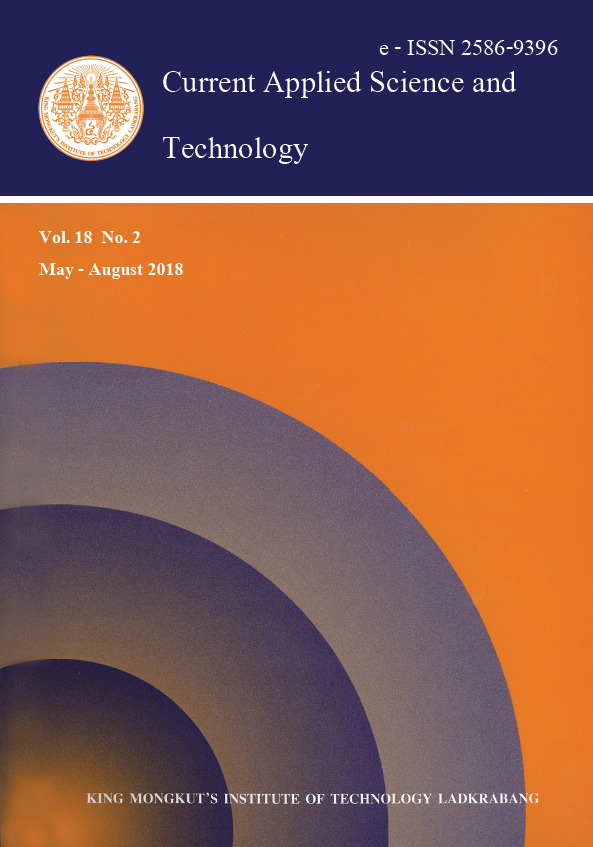UV Shielding Properties of Cellulose/TiO2 Composite Film
Main Article Content
Abstract
Cellulose/TiO2 composite film was prepared for UV shielding applications. Cellulose was extracted from sugarcane bagasse by ball milling process. The cellulose/ TiO2 composite film with different concentrations of cellulose showed a synergic feature of optical transparency and UV-blocking. The crystalline structure of cellulose was characterized by X-ray diffraction (XRD). The treated cellulose has higher crystallinity than the untreated cellulose. Fourier transform infrared spectroscopy ( FTIR) analysis shows the evidence of chemical treatment hemicellulose and lignin removal from sugarcane bagasse. The optical properties were measured by UV- Vis spectrometer, the results of TiO2 and cellulose solution correspond to UV- A and UV- C absorbance regions with high transparent of cellulose composite films. The revealed results are essential for UV protecting
materials application.
Keywords: nanocellulose composite, TiO2, UV-shielding, ball milling
*Corresponding author: E-mail: [email protected]
Article Details
Copyright Transfer Statement
The copyright of this article is transferred to Current Applied Science and Technology journal with effect if and when the article is accepted for publication. The copyright transfer covers the exclusive right to reproduce and distribute the article, including reprints, translations, photographic reproductions, electronic form (offline, online) or any other reproductions of similar nature.
The author warrants that this contribution is original and that he/she has full power to make this grant. The author signs for and accepts responsibility for releasing this material on behalf of any and all co-authors.
Here is the link for download: Copyright transfer form.pdf
References
[2] Li, W., Yue, J. and Liu, S., 2012. Ultrasonics Sonochemistry, 19, 479-485.
[3] Mandal, A. and Chakrabarty, D., 2011. Isolation of nanocellulose from waste sugarcane bagasse (SCB) and its characterization. Carbohydrate Polymers, 86, 1291-1299.
[4] Habibi, Y., Lucia, L.A. and Rojas, O., 2010. Cellulose nanocrystals: Chemistry, self-assembly, and applications. Chemical Reviews, 110, 3479-3500.
[5] Oliveira, F.B.d. et al., 2016. Production of cellulose nanocrystals from sugarcane bagasse fiber and pith. Industrial Crops and Products, 93, 48-57.
[6] Phanthong, P., Guan, G., Ma, Y., Hao, X. and Abudula, A., 2016. Effect of ball milling on the production of nanocellulose using mild acid hydrolysis method. Journal of the Taiwan Institute of Chemical Engineers, 60, 617-622.
[7] Zhao, H., Kwak, J.H., Wang, Y., Franz, J.A., White, J.M., and Holladay, J.A., 2006. Effects of crystallinity on dilute acid hydrolysis of cellulose by cellulose ball- milling study. Energy and Fuels, 20, 807-811.
[8] Julkapli, N.M. and Bagheri, S., 2017. Progress on nanocrystalline cellulose biocomposites. Reactive and Functional Polymers, 112, 9-21.
[9] Morawski, A. W., Kusiak-Nejman, E., Przepiórski, J., Kordala, R. and Pernak, J. 2013. Cellulose-TiO2 nanocomposite with enhanced UV-Vis light Absorption. Cellulose, 20(3), 1293-1300.
[10] Ouyang, X., Wang, W., Yuan, Q., Li, S., Zhang, Q. and Zhao, P., 2015, Improvement of lignin yield and purity from corncob in the presence of steam explosion and liquid hot pressured alcohol. RSC Advances, 5, 61650-61656.
[11] Rahimi Kord Sofla, M., Brown, R.J., Tsuzuki, T. and Rainey, T.J. 2016. A comparison of cellulose nanocrystals and cellulose nanofibres extracted from bagasse using acid and ball milling methods. Advances in Natural Sciences: Nanoscience and Nanotechnology, 7(3),1-9.
[12] Alemdar, A. and Sain, M., 2008. Isolation and characterization of nanofibers from agricultural residues - wheat straw and soy hulls. Bioresource Technology, 99, 1664-1671.
[13] Mandal, A. and Chakrabarty, D., 2011. Isolation of nanocellulose from waste sugarcane bagasse (SCB) and its characterization, Carbohydrate Polymers, 86, 1291-1299.
[14] Sain, M. and Panthapulakkal, S., 2006. Bioprocess preparation of wheat straw fibers and their characterization. Industrial Crops and Products, 23, 1-8.
[15] Li, W., Wu, Q., Zhao, X., Huang, Z, Cao, J., Li, J., and Liu, S., 2014. Enhanced thermal and mechanical properties of PVA compositesformed with filamentous nanocellulose fibrils. Carbohydrate Polymers, 113, 403-410.
[16] Moon, R.J., Martini, A., Nairn, J., Simonsen, J. and Youngblood, J., 2011. Cellulose nanomaterials review: Structure, properties and nanocomposites. Chemical Society Reviews,40, 3941-3994.
[17] Wu, R-L., Wang, X-L., Wang, Y-Z., Bian, X-C. and Li, F., 2009. Cellulose/soy protein isolate blend films prepared via room-temperature ionic liquid. Industrial and Engineering Chemistry Research, 48, 7132-7136.

